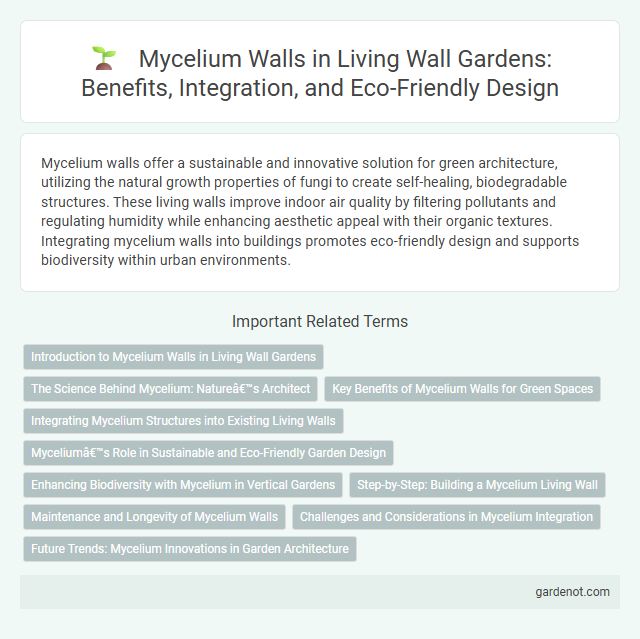Mycelium walls offer a sustainable and innovative solution for green architecture, utilizing the natural growth properties of fungi to create self-healing, biodegradable structures. These living walls improve indoor air quality by filtering pollutants and regulating humidity while enhancing aesthetic appeal with their organic textures. Integrating mycelium walls into buildings promotes eco-friendly design and supports biodiversity within urban environments.
Introduction to Mycelium Walls in Living Wall Gardens
Mycelium walls integrate fungi-based networks to create sustainable, biodegradable structures within living wall gardens, enhancing air purification and natural insulation. These walls harness the mycelium's cellular structure to support plant growth while promoting a self-regulating ecosystem that reduces urban heat and improves biodiversity. Incorporating mycelium in vertical gardens offers innovative solutions for eco-friendly architecture and green urban spaces.
The Science Behind Mycelium: Nature’s Architect
Mycelium, a network of fungal threads called hyphae, acts as nature's architect by forming dense, interwoven structures that provide strength and flexibility to living walls. This biological matrix supports plant growth by retaining moisture, enhancing soil health, and facilitating nutrient exchange through symbiotic relationships with plant roots. Harnessing mycelium's natural properties enables sustainable, biodegradable wall systems that promote ecological balance and improve indoor air quality.
Key Benefits of Mycelium Walls for Green Spaces
Mycelium walls enhance green spaces by improving air quality through natural filtration of pollutants and carbon dioxide. They support biodiversity by providing habitats for beneficial microorganisms and insects, promoting ecosystem health. These walls also offer sustainable insulation, reducing energy consumption and creating a cooler environment in urban areas.
Integrating Mycelium Structures into Existing Living Walls
Integrating mycelium structures into existing living walls enhances structural stability and promotes natural biodegradation, creating a self-sustaining ecosystem. Mycelium's network-like growth pattern facilitates nutrient exchange and moisture retention, improving plant health and resilience. This fusion supports eco-friendly wall installations by combining fungal biology with plant biodiversity for optimized green infrastructure.
Mycelium’s Role in Sustainable and Eco-Friendly Garden Design
Mycelium plays a crucial role in sustainable garden design by acting as a natural, biodegradable material that enhances soil health and promotes plant growth. Its ability to break down organic matter supports nutrient cycling, reducing the need for synthetic fertilizers in living walls. Integrating mycelium into living walls not only improves air quality but also boosts the structural integrity and moisture retention of garden installations.
Enhancing Biodiversity with Mycelium in Vertical Gardens
Mycelium walls in vertical gardens significantly enhance biodiversity by creating a rich, natural habitat for various microorganisms, insects, and plants. The mycelium network supports nutrient cycling and soil health, fostering symbiotic relationships that promote plant growth and resilience. Incorporating mycelium into living walls contributes to sustainable urban ecosystems by increasing species diversity and ecological balance.
Step-by-Step: Building a Mycelium Living Wall
Creating a mycelium living wall begins with selecting a sturdy frame and preparing a breathable substrate rich in organic materials such as straw or wood chips to support fungal growth. Next, inoculate the substrate with mycelium spores, ensuring even distribution and maintaining optimal humidity and temperature levels to encourage mycelium colonization. Finally, regularly monitor moisture and light conditions, allowing the mycelium to integrate with plant roots, forming a sustainable, self-supporting living wall that enhances air quality and aesthetic appeal.
Maintenance and Longevity of Mycelium Walls
Mycelium walls require minimal maintenance due to their natural resistance to pests, mold, and humidity, ensuring a durable and sustainable surface. Their self-healing properties enable them to recover from minor damages, significantly extending their lifespan compared to traditional building materials. Regular inspection for moisture control and structural integrity is essential to maximize the longevity of mycelium walls in both residential and commercial applications.
Challenges and Considerations in Mycelium Integration
Mycelium walls face challenges such as maintaining optimal moisture and temperature levels to support fungal growth without causing structural damage. Integration requires careful selection of compatible substrates and materials to ensure durability and mold prevention. Long-term maintenance considerations include monitoring for decay and managing potential biohazards associated with fungal proliferation.
Future Trends: Mycelium Innovations in Garden Architecture
Mycelium walls represent a cutting-edge trend in garden architecture, leveraging fungi's natural growth to create sustainable, biodegradable structures that enhance air quality and biodiversity. Emerging innovations include integrating mycelium composites with smart sensors to monitor plant health and optimize microclimates within living walls. Future developments focus on scalable mycelium cultivation techniques, enabling lightweight, self-regenerating vertical gardens adaptable to urban environments.
Mycelium wall Infographic

 gardenot.com
gardenot.com